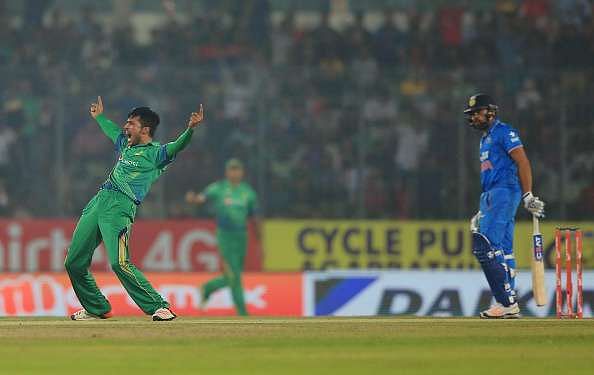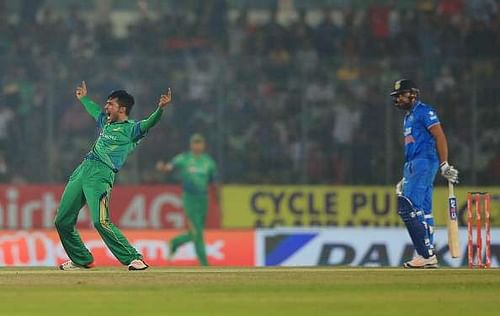
ICC World T20 2016: Can the bowlers lead Pakistan to World T20 glory?

A scorching yorker, angling across and then bending back into the right-hander. Hits the batsman full on the toe, must have caused a lot of pain. An LBW appeal is rejected. The disappointed bowler walks back to the start of his run-up. He charges in and bowls a follow-up special. This time, the ball pitches slightly shorter, around the good length area, moves away initially but gently bends back in. Misses the bat, hits the pad. Plumb. Rohit Sharma is out for nought.
Two balls later, the moment of magic returns. Almost an instant replay of the previous dismissal – Ajinkya Rahane, too, is out without opening his score. 2 runs, with 2 wickets down.
The bowling team drags India to 8/3 before one of the world’s most in-form player weathers the storm. It’s 76/4 next and then 76/5. The batting team eventually wins, but not before breaking a sweat or two – India’s line up was always meant to chase down a target of 84 in 20 overs. The chase wasn’t supposed to be this difficult though.
Pakistan cricket – creating magic amidst chaos
Erratic, inconsistent, undependable. There are multiple ways of describing this Pakistani bowling attack that gave a star-studded Indian batting lineup a run for its money, with just 83 runs to defend. But can one tread a slightly different path and declare this attack to be the best in the business currently? Perhaps.
The beauty of Pakistan cricket lies in its ability to evoke extreme emotions at a particular moment in time. It’s organised chaos that more often than not creates magic. Like an Umar Akmal jab piercing the off-side field with precision, to reach the boundary; followed by an Umar Akmal hoik trying to send a ball on the fifth stump across to mid wicket – only for it to end in a fielder’s hands.
In most cases, Pakistan’s brilliance on the field has been overshadowed by its shenanigans off it. Somehow when the spotlight has been on the field, the misses have got more attention than the hits, that’s the thing about the “unquiet ones”.
Hence, it becomes almost dangerous to declare that Pakistan’s T20 bowling attack is the best in the world. To put one’s money on a unit that often goes into self-destruct mode is a risky proposition. To isolate just a facet of its game and declare it the best in a world that has far more disciplined attacks operating, is riskier.
But the risk needs to be taken. We are talking of a young left-armer who is making up for his five years long international hiatus, a seasoned pro who can make the old ball talk and a bunch of others who fill up spaces in the jigsaw puzzle, quite perfectly at that.
So let’s try asking the question again. Is Pakistan’s bowling attack the best in the business currently? Indeed.
A bowling package not to be tampered with

Pakistan enter the World T20 2016 with a bowling attack that comprises of Mohammad Amir, Mohammad Sami, Mohammad Irfan and Wahab Riaz. Then there’s the wily old Shahid Afridi and the measured off-spinning option in Shoaib Malik. There’s new ball prowess, death bowling efficiency and middle-overs containment. A package not to be tampered with.
It’s significant to note that while Pakistan has just won three out of its seven T20 internationals this year, more often than not it has been the bowlers making a fight out of the match.
While India limped to 84/5 to win their match in the Asia Cup, Bangladesh too, were dragged into the final six deliveries of the game in order to land a win against Pakistan, chasing just 130 runs.
In the thick of the things is Mohammad Amir, who along with Mohammad Irfan and on occasions, Mohammad Sami, has ensured that there’s potency in the new ball attack. Barring just the one game where New Zealand strode to a 10 wicket win, Pakistan has managed to pick up at least one wicket in the Power Play overs.
Irfan who has picked up a wicket in every nineteen deliveries he’s bowled in 2016, has an outstanding economy rate of nearly five and a half runs per over – translating into a pressure build-up that has allowed Amir to pick up wickets from the other end.
The middle-overs have often been dictated by spin from one end and an attacking option from the other end. At times, it has been Amir, and other times it’s been part-timers as partnership breakers.
It’s towards the end of the innings that the likes of Wahab Riaz become critically important to Pakistan. The left-armer has been the most expensive of Pakistan’s bowlers but has been very consistent as a death bowling option – taking wickets regularly.
What stands out amidst all these numbers is the fact that Pakistan has managed to take wickets in bunches. In a contest where a wicket often leads to stemming of the run-flow, dismissing two or three opposition batters in a span of a few deliveries is hugely impactful.
New Zealand went from 89/1 to 108/6 at Auckland. Similarly, at Wellington, they went from 57/0 to 62/2. UAE were 5/0 and soon became 12/3, and Bangladesh were 83/2 when Mohammad Amir struck twice, taking the score to 104/5 (Shoaib Malik picked up one wicket).
Will this attack win Pakistan a second World T20?

Leaving aside India, a side that seems well rounded despite leaning slightly towards Jasprit Bumrah and Ravichandran Ashwin for its edge, there isn’t any team in the world currently that possesses the skills of the Pakistan bowling attack. In Sami, Riaz, and Afridi, there’s a mountain of experience. In Amir and Irfan, there’s youthful exuberance. In Anwar Ali, there’s a capable back-up.
It’s hard not to miss the writing on the wall here. If Pakistan is to win the T20 World Cup after seven years, all it needs is some support from the batsmen. This attack is capable of defending low totals as well as it is capable of bundling out the opposition easily. Will Amir & Co. succeed? It’s over to Kolkata.